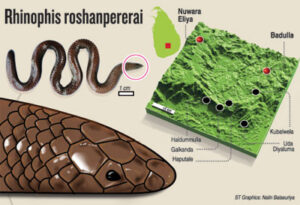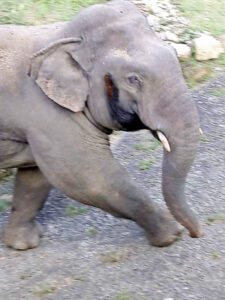
Waste and affluence: More money, more garbage
 The catastrophe that was Meethotamulla in mid-April during what should have been a joyous time of anticipating a New Year was a stark warning of a serious man-made disaster that can recur, not just in Kolonnawa but in other areas as well.
The catastrophe that was Meethotamulla in mid-April during what should have been a joyous time of anticipating a New Year was a stark warning of a serious man-made disaster that can recur, not just in Kolonnawa but in other areas as well.
Smaller dumps due to indiscriminate dumping can be seen rising up in various parts of the country while “sili sili” bags hanging off thorny bushes, glistening silver wrappers amongst the water lilies, multi coloured plastic pieces scattered on the beaches are becoming part of our natural scenery. We are caught in a paradox of a more affluent country drowning in garbage.
Solid waste and affluence have a positive co-relationship. Studies show that as societies become wealthier, they generate more food waste (organic) as well as more non-organic items such as paper and plastic packaging, electronic waste etc. The less affluent are much better recyclers – out of necessity. Thus, more disposable income results in more “disposable” products.
A World Bank study aptly titled “What a waste” claims that not just affluence but urban living also leads to more solid waste. The report estimates that by 2025, 4.3 billion urban residents will generate about 1.42 kg of solid waste per capita per day. Solid waste management is one of the largest recurring costs for municipal and urban authorities and the cost is said to see a four-fold (or more) increase in lower-middle income countries in the next decade. Although this study, conducted in 2012, says that South Asia is one of the regions generating the least waste, this trend will change, with projected increase in urbanisation and incomes. So how will we manage our waste?
Solid waste management is a pressing environmental problem. It is assumed that the prime responsibility of waste management rests squarely on the authorities that are supposed to manage waste. After all, as residents, we pay taxes and it is the job of the local authority to have systems in place and planned living spaces with adequate attention to waste disposal. While it is of utmost importance that waste management systems are in place, does it not also warrant some sort of action from us, the ones generating the garbage? 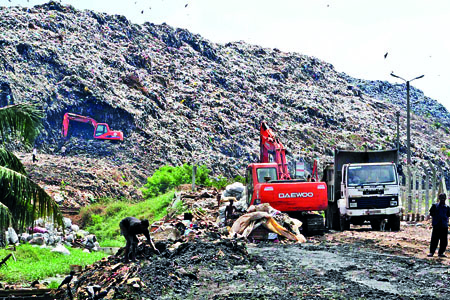
Our current growth model is run on consumption, and wellbeing is heavily reliant on material things. We do not worry too much about what we spew out as waste into the environment. This mode of operating is a crucial factor driving climate change as we are emitting more waste than the environment can absorb. Eventually this will come back to bite us. As is the case with most things related to climate change, it can also affect those who had the least to do with the problem.
Hence a new way of thinking or bringing back an old concept of growing within our means is needed. This requires thinking of the production cycle like a closed system (circular economy), where natural resources are used and reused to the maximum and what needs to be managed as waste is minimised. Some companies have proactively sought to adopt these approaches but such practices are yet to be fully embraced in our society. Other ideas that are slowly emerging are for consumers to rent or lease products and give it back to be ‘transformed’ into new products. Thus, cutting out waste and also reorienting the idea of ownership.
Garbage also has external costs such as illnesses and increased cost of living but also infringes on the rights of people to live in a clean and healthy environment. These are also the reasons why we need to go that extra mile and reflect on our own consumption patterns. So in our quest for more affluence, a more conscious effort is needed to guide us on what we throw away.
The fundamental for waste management from a consumer end is separation of garbage but also minimization of garbage. It is not as if we have to learn or be taught about minimising waste from scratch. Traditionally, people would recycle – from glass bottles to jam jars to used clothes and kitchen waste. We are also seeing so many more creative ways in which waste from one source can be “upclycled” or converted into something else. It will not happen overnight and much effort is needed – but it is also in our best interest for a healthier life. Hence, in this post-Meethotamulla debate about waste management, while we badly need better waste management services, it is also important to rethink what we consider waste and to put more emphasis on the individual’s responsibility towards minimising waste.
This would be the citizen’s contribution to wellbeing.
Source – 28/05/2017, The Sunday Times, See more at – http://www.sundaytimes.lk/170528/business-times/waste-and-affluence-more-money-more-garbage-242361.html

Roadkill leads to discovery of burrowing snake
A new burrowing snake was added to the list of species endemic to Sri Lanka when International Day of Biological Diversity was marked on Monday, strengthening the country’s image as a biodiversity hotspot.
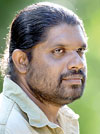
A new non-venomous ‘shield tailed snake’ that lives under the soil was discovered from the Badulla District. The scientific paper describing this new species appeared in prestigious scientific journal ZooTaxa.
The new species is yet another discovery by veteran herpetologist Mendis Wickremasinghe, who recalls that he first saw the snake as a single roadkill specimen in 1999 in Beragala. Later, during an island-wide herpetology survey, Mr Wickremasinghe decided to search the area.
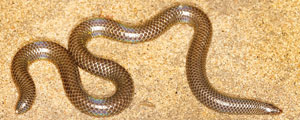 The researchers dug randomly selected locations that are habitats for such species. They got lucky and found a snake hidden under the soil layer of a banana plant of a home garden in 2010. The snake was found about 15 centimetres deep and had a highly-modified head, bearing a blade-like rostral scale for burrowing.
The researchers dug randomly selected locations that are habitats for such species. They got lucky and found a snake hidden under the soil layer of a banana plant of a home garden in 2010. The snake was found about 15 centimetres deep and had a highly-modified head, bearing a blade-like rostral scale for burrowing.
Mr. Wickremasinghe said about 30 individuals could be observed during subsequent visits to the same locations. More such snakes were observed from the same locality and in suburban areas like Haldummulla with some of them seen moving above ground at night.
With the new discovery, this rhinophis genus now has 20 such snake species with 16 of them found in Sri Lanka that are endemic to the country. The other four snakes are endemic to India. Three of these Sri Lankan species have been recently described in 2009 and 2011. Mr Wickremasinghe said there could be more snake species that belongs to this group, emphasising need for more studies.
Dulan Ranga Vidanapathirana and Gehan Rajeev too assisted in this new finding. Mr Wickremasinghe also thanked the principal sponsors, Dilmah Conservation.
Source – 28/05/2017,The Sunday Times, Read more at – http://www.sundaytimes.lk/170528/news/roadkill-leads-to-discovery-of-burrowing-snake-242678.html

Sinharaja elephant attacks raise villager fury
The recent photograph that shows an elephant in musth
By Malaka Rodrigo
Sri Lanka’s biodiversity hotspot, Sinharaja, is home to two elephants – but pressure is mounting to translocate them after one killed two villagers. Last week, some angry villagers demanded the elephants be removed as a man and a woman were killed in Cypresswatte village.
The incident happened on May 16. The woman was killed at about 6:45 p.m., while the man was fatally attacked around 8 p.m.
A few days earlier, on May 13, the same elephant attacked a Wildlife Department jeep when the vehicle was involved in chasing the animal back into the forest. This incident was near Kudawa, Weddagala around 8.30 p.m. The panicked animal turned back and crushed the bonnet of the vehicle, slightly injuring those inside.
The elephant had been seen at other locations. It had paced around the tower on top of the Gongala Mountain. A photo taken at Gongala shows the elephant is in musth, which is the periodical rise of reproductive hormones of a bull elephant. At such times the animals are irritable and aggressive.
According to DWC records, the two Sinharaja elephants are responsible for 16 human deaths in villages such as Kopi-kella, Manikkawatte and Cypresswatte. Tea cultivations block their natural passages, forcing them to sometimes wander into populated areas.
Madura De Silva, the president of the Wildlife Conservation Society of Galle, said that there were three elephants sometimes back – one female and two males. The society setup camera traps as a part of a project related to leopards and the cameras captured the movements of an elephant. With the data they mapped its range.
DWC director general, W S K Pathiratne, said a decision had not been taken yet to translocate the killer elephant. More wildlife officers will be sent to the are.
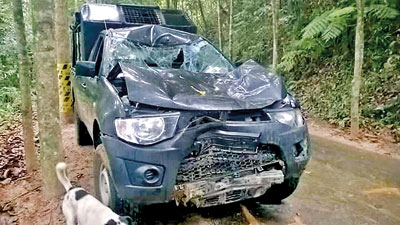 When asked if a radio collar could be fitted to track the animal, he said trapping the elephant would be challenging in the difficult terrain.
When asked if a radio collar could be fitted to track the animal, he said trapping the elephant would be challenging in the difficult terrain.
The elephant was in fact caught in 1999 by a team led by Dr Nandana Atapattu – a veterinary surgeon who was also a deputy director of DWC then. It took a team of 20 and a week-long effort. But villagers at the time, particularly the students of Kajuwatta School protested against removing the elephant saying it was an asset to the area. Dr Atapattu released the elephant.
At that time, there were records that the elephant charged but did not kill anyone.Environmentalist Jayantha Wijesinghe said these elephants roamed widely around Sinharaja, but attacked people only in some places. “The reason being that the villagers in these areas have harmed the duo, so the elephants become more aggressive,” he said.
The president of the Wildlife Conservation Society of Galle, Mr De Silva, said that in many areas, the local villagers understand the elephant’s movements and that helps to avert a potential disaster. He also said that because of the elephants, illegal activities such as felling trees for ‘walla patta’ and gem mining has been under control. “These elephants are the jewels of Sinharaja. it is better to let them be.”
The Sinharaja rainforest is a UNESCO World Heritage Man and Biosphere Site.
Source – 28/05/2017, The Sunday Times , Read More at – http://www.sundaytimes.lk/170528/news/sinharaja-elephant-attacks-raise-villager-fury-242684.html

